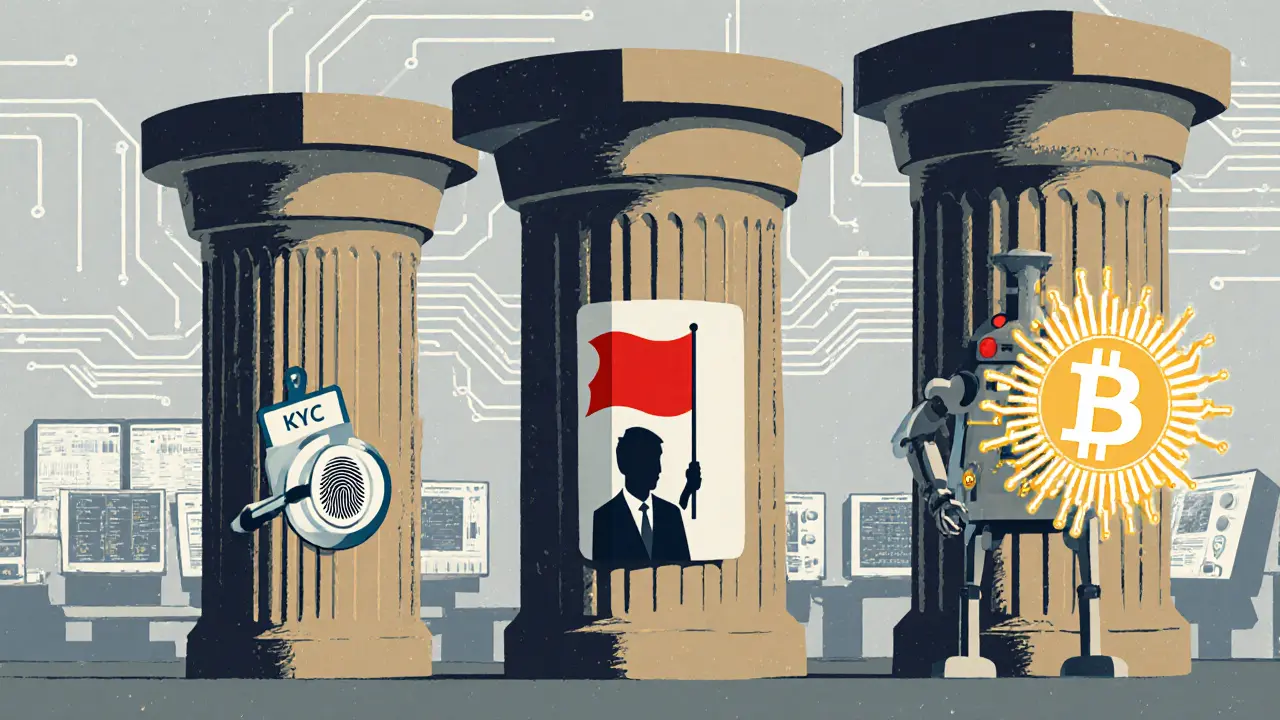
Crypto Compliance Program Cost Estimator
Compliance Cost Calculator
Estimate your annual compliance costs based on transaction volume and jurisdiction. This tool helps you understand the financial commitment required to maintain a compliant crypto business in 2025.
Estimated Annual Compliance Costs
Low End: $0
Mid Range: $0
High End: $0
Cost Breakdown
| Cost Category | Low End | Mid Range | High End |
|---|---|---|---|
| Consulting & Licensing Fees | |||
| Technology Stack | |||
| Staff Salaries | |||
| Ongoing Audits & Certifications |
Key Insights
Compliance Requirements by Jurisdiction
United States
- Up to 47 state licenses
- FinCEN, SEC, CFTC, NYDFS
- $125k-$250k net worth requirement
- 5-year record retention
European Union
- Single MiCA VASP license
- ESMA, national regulators
- €125,000 minimum capital
- 5-8 year retention
United Arab Emirates
- VARA or ADGM/DIFC licenses
- VARA, ADGM, DIFC regulators
- USD 100k-$250k capital
- Real-time analytics required
Running a crypto exchange, wallet service, or any digital‑asset platform today means juggling a maze of rules that change faster than market prices. A solid compliance program is the only way to stay legal, keep institutional partners happy, and avoid costly enforcement actions. This guide walks you through what a crypto compliance program looks like in 2025, how regulations differ across the US, EU, and UAE, and the practical steps you need to launch or upgrade yours.
What is a Crypto Compliance Program?
Compliance Program for Crypto Companies is a structured framework that enables digital‑asset businesses to meet evolving global regulatory requirements. It combines policies, procedures, technology, and trained staff to prevent money‑laundering, terrorist financing, fraud, and other illicit activities while allowing legitimate transactions to flow. The program’s core value is threefold: regulatory approval, enhanced trust with institutional investors, and reduced legal and reputational risk.
Core Pillars of a Modern Program
In 2025 the industry converges on three interconnected pillars.
- KYC (Know‑Your‑Customer) identity verification that confirms who a user is before they can trade or transfer crypto assets. Tiered verification ranges from email confirmation for sub‑$1,000 activity to Enhanced Due Diligence (EDD) for transactions over $3,000.
- AML/PEP Screening continuous monitoring for money‑laundering patterns and Politically Exposed Persons. Real‑time checks against sanctions lists, adverse media, and watch‑lists are essential.
- Transaction Monitoring AI‑driven analysis of blockchain flows to flag suspicious behavior, meet the Crypto Travel Rule, and produce audit‑ready reports. Modern solutions handle 10,000+ transactions per second with 98.7% accuracy in detecting anomalies.

Global Regulatory Landscape in 2025
The biggest compliance headaches come from jurisdictional differences. Below is a snapshot of the three leading regimes.
| Jurisdiction | Key Regulator(s) | License Type | Capital Minimum | Record‑Retention | Typical Cost (Annual) |
|---|---|---|---|---|---|
| United States | FinCEN, SEC, CFTC, NYDFS, 47 state money‑transmitter authorities | VASP (Virtual Asset Service Provider) registration + state licenses | Varies; no EU‑style minimum, but $125k‑$250k net‑worth often required by states | 5 years (FinCEN) | $300,000‑$1,200,000 |
| European Union | European Securities and Markets Authority (ESMA), national regulators under MiCA | MiCA VASP license (single pan‑EU) | €125,000 minimum capital | 5‑8 years (varies by member state) | $150,000‑$600,000 |
| United Arab Emirates | VARA (Dubai), ADGM/DIFC financial regulators | VARA Crypto License or ADGM/DIFC VASP permit | USD 100,000‑USD 250,000 depending on scope | 5 years (VARA) / 8 years (ADGM‑DIFC) | $100,000‑$450,000 |
Key take‑aways:
- The US demands the most licenses - up to 47 state permits - driving up cost and administrative load.
- MiCA offers a single license across 27 EU members, simplifying cross‑border expansion.
- UAE frameworks are fast‑track (average 90‑day licensing) but require strict real‑time analytics per the June2025 VARA update.
Building Your Compliance Program: Step‑by‑Step
- Regulatory Gap Analysis: Map the jurisdictions you serve, then list applicable statutes (FinCEN BSA, MiCA, VARA, etc.). Use a matrix to spot missing controls.
- Policy Development: Draft KYC, AML, data‑retention, and incident‑response policies. Reference the three‑pillar model and embed risk‑based thresholds (e.g., $1k basic, $3k enhanced).
- Technology Stack Selection: Choose identity verification providers (Sumsub, Onfido, Veriff), transaction monitoring engines (Chainalysis, CipherTrace, or AI‑built solutions), and blockchain explorers for on‑chain data.
- Integration & Automation: Use APIs to feed verification results into onboarding flows, and feed blockchain transaction data to monitoring dashboards. Ensure real‑time Crypto Travel Rule data exchange between VASPs.
- Staffing & Training: Hire or upskill analysts with both AML/KYC experience and blockchain knowledge. Only about 12% of traditional compliance pros have this blend, so partner with specialized consultants if needed.
- Record‑Keeping Infrastructure: Deploy encrypted, tamper‑evident storage that meets regional retention (5‑8 years). Consider immutable ledger storage for auditability.
- Testing & Certification: Run simulated transactions, conduct penetration testing on APIs, and obtain third‑party attestations (e.g., SOC2) before launch.
- Ongoing Monitoring & Updates: Set a quarterly review cycle to capture regulatory changes (MiCA extensions, US Treasury proposals) and adjust thresholds or vendor contracts.
Typical implementation time is 6‑9 months for a mid‑size exchange and 12‑18 months for a large platform.
Cost Breakdown and Budgeting
Compliance spending is a major line item. Below is a rough cost model for a mid‑tier exchange processing $200M in monthly volume.
| Cost Category | Low End | Mid Range | High End |
|---|---|---|---|
| Consulting & Licensing Fees | 50,000 | 200,000 | 500,000 |
| Technology Stack (APIs, monitoring, data storage) | 80,000 | 250,000 | 600,000 |
| Staff Salaries (analysts, engineers, legal) | 150,000 | 400,000 | 900,000 |
| Ongoing Audits & Certifications | 30,000 | 100,000 | 250,000 |
| Total | 310,000 | 950,000 | 2,250,000 |
Most firms fall between the mid‑range $950k and $1.2M band. The upside is that 78% of institutional investors will not engage without a documented compliance program, so the ROI comes from access to capital.

Common Challenges & Practical Solutions
Even with a roadmap, companies hit snags. Here are the top five and how to overcome them.
- Multi‑jurisdictional License Management: Use a centralized compliance dashboard that tracks renewal dates, capital requirements, and filing status for each regulator.
- Balancing KYC Rigor with User Experience: Deploy tiered onboarding - let low‑risk users start with email verification and upgrade them automatically as transaction volume grows.
- Integrating On‑Chain Analytics: Choose a monitoring vendor that offers pre‑built blockchain connectors (e.g., Chainalysis Kryptos) to avoid custom code for each ledger.
- Data Privacy vs. Disclosure: Leverage zero‑knowledge proofs to share only hashed identifiers for the Travel Rule, satisfying both GDPR and FinCEN.
- Keeping Up with Rapid Rule Changes: Subscribe to regulator newsletters, join industry coalitions (e.g., Global Digital Finance), and allocate a compliance‑lawyer half‑time to monitor proposals.
Best Practices & Pro Tips for 2025
- Adopt a risk‑based approach: allocate more resources to high‑volume, high‑value crypto pairs and to jurisdictions with stricter AML laws.
- Maintain modular architecture - separate KYC, AML, and monitoring services so you can swap out a vendor without rewriting the whole stack.
- Document every policy change with version control; auditors love timestamps.
- Run periodic “red‑team” simulations where a mock bad actor tries to bypass KYC - you’ll spot gaps before regulators do.
- Publish a concise compliance summary on your website; it builds trust with investors and may reduce regulator scrutiny.
Frequently Asked Questions
Do I need a compliance program if my platform only handles crypto-to-crypto swaps?
Yes. Even pure crypto swaps fall under the FinCEN Travel Rule and MiCA AML provisions when the swap exceeds $3,000. Most regulators view the swap as a transfer of virtual assets, so KYC and transaction monitoring are required.
How long must I keep transaction records?
Retention depends on jurisdiction: 5 years under US FinCEN, 5 years in Dubai (VARA), 8 years in ADGM/DIFC, and at least 5 years across the EU under MiCA. Align your storage to the longest period required for the markets you serve.
Which KYC provider gives the best price‑to‑performance ratio?
Sumsub scores highest for ease of integration (4.5/5) but is pricey. Onfido offers a more transparent tiered pricing model, while Veriff provides strong document verification at a mid‑range cost. Choose based on your transaction volume and the level of EDD you need.
Can I reuse the same compliance program for both a centralized exchange and a DeFi protocol?
Partially. Centralized services must meet the full KYC‑AML stack, while DeFi protocols often qualify for a lighter “gateway” approach under MiCA’s upcoming 2026 extension. However, any on‑ramp that links users to DeFi still needs robust KYC and AML checks.
What is the biggest cost driver in a compliance program?
Licensing and consulting fees dominate for US‑focused firms (up to 47 state licenses). In the EU, technology stack and ongoing monitoring are the main expenses, while UAE costs are driven by rapid licensing fees and real‑time analytics requirements.





Comments (8)
Laura Myers
Crypto compliance is no longer a back‑office afterthought; it's the front door to legitimacy. The guide nails the three‑pillar model that everyone keeps quoting at conferences. I love how the EU section highlights MiCA's single‑license advantage – it really cuts the bureaucratic noise. The cost tables make the scary numbers digestible, especially for startups eyeing a $1M budget. Bottom line: if you skip this roadmap, expect regulatory headaches later.
Leo McCloskey
While the article provides a decent overview, it glosses over the intricacies of AML‑CFT integration, which, in practice, involves a labyrinth of transaction monitoring APIs, layered KYC verification stacks, and jurisdiction‑specific sanctions screening, not to mention the inevitable data‑privacy conflicts with GDPR; moreover, the cost breakdown fails to account for hidden consultancy fees that can inflate budgets by up to 30 %.
arnab nath
Every "compliance" checklist is a front for the hidden agenda of global financial surveillance.
Nathan Van Myall
The step‑by‑step section is practical, especially the gap‑analysis matrix that forces teams to map every regulator. Integrating identity providers via APIs can be done in a weekend if you follow the open‑source SDKs. Real‑time Travel Rule exchanges are still a pain point, but the guide’s suggestion to use a modular architecture helps. Keep the quarterly review cadence; regulations move faster than market sentiment.
debby martha
i think the cost model looks too optimistic, especially for US firms juggling 47 state licenses. you cant just slap a $200k number and call it done. the real expense is the legal overhead you cant see in a spreadsheet. still, the article does a good job breaking down the tech stack part.
Philip Smart
Honestly, the biggest mistake I see startups make is underestimating staff salaries. The guide mentions analysts and engineers, but the market rates for AML specialists have surged past $150k annually. Also, the licensing fees in the US are a nightmare – don't forget the indirect costs of compliance audits. On the upside, the tech stack recommendations (Chainalysis, CipherTrace) are solid choices for scalability. If you can afford the mid‑range budget, you’ll be well‑positioned for institutional partnerships. Bottom line: budget for people, not just tools.
Lena Vega
The modular architecture tip is spot on. It saves you from vendor lock‑in later.
Mureil Stueber
When choosing a KYC provider, consider both verification speed and geographic coverage. Sumsub offers a good balance, but Onfido’s tiered pricing can be more cost‑effective for growing volumes. Also, encrypt all stored records using AES‑256 to satisfy both US and EU retention rules. Finally, schedule a yearly SOC 2 audit to keep auditors happy.